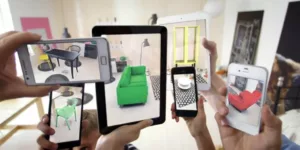Augmented Reality (AR) is steadily evolving into the consumer-ready technology. Though, it’s pretty ugly nowadays comparing to over-hyped promises we herd over the years.
Fortunately, the demand is also pushing entrepreneurs forward. There are 3000+ startups engaged in Augmented Reality that have been listed on Angellist. It is expected that their user base will grow up to 1 billion by the end of 2020.
Now the SMBs can develop their own AR apps for various of application, starting from pure marketing and ending with maintenance apps, that will help customers to keep an eye on their products.
The Reality of Consumer-grade AR Experience
Apart from messy enterprise-grade AR apps, there are also B2C AR apps, that can be developed for a reasonable budget right now. There is no future tech and stunning Hollywood-like experiences, but only a utilitarian purpose-driven apps.
There are three key purposes of such apps:
- User Education & Onboarding – AR Experience can also serve as an onboarding point. From here company can lead customers further into the sales funnel up to the moment when they are fully educated about the products and their true values.
- Better User Engagement – AR and VR add the whole new dimension to the way that humans interact with products that helps you to operate and service your product. This can lead to a longer warranty period or the company can use AR as an additional value point in its marketing strategy.
- Reduced Maintenance Costs – AR allow you to bridge the digital and physical worlds. It allows you to leverage the richness of 3D and the insights from the digital space and present it all in the most compelling way imaginable through the power of augmented reality. Meaning you can now do without hiring costly service workers or reduce the number of issues the require specialized maintenance.
Development of AR App
The development of every AR experience starts with bringing in some 3D data. If you’re from the manufacturing domain then you may use original 3D models and can reuse some CAD data to build AR experience. If you’re not, the price tag starting from as little as $200 for a simple 3D-prototype of your product.
3D Data Import
It must be acknowledged that engineering-grade CAD data is very high-fidelity. It’s built to do very sophisticated things like manufacturing, CFD (computational fluid dynamics), and analysis. An industrial-grade Caterpillar’s generator CAD file can weight as much as 1.2GB.

Considering that an average weight of the webpage now is around 2Mb, you should reduce the size of AR file under 10MB.
Obviously, your client won’t be happy to download a single GB-sized AR file on the phone. In case with consumer-level 3D, we only need to trick the human eye, so we can radically simplify the geometry of the 3D model.
Identification Marker

The app may also require an ID Marker on the product. The marker provides the unique ID, so that the AR app could know which file to download from the cloud. It can be a QR code, barcode, or simply a link that will direct the app to your cloud database.
Decide whether to host AR app on your own servers, or buy some space on AWS or any other cloud storage. If you’re moving into the cloud check whether you need CDN in order to provide your client with low latencies whenever they are in the world.
Secondly, the marker provides AR placement. Think of it as an anchor. It allows the app to identify the starting point from where it should build AR Experience, so when you move the camera the 3D-layer stays in the same place.
Simultaneous Localization and Mapping
Commercial-grade AR tools require additional computer vision technology in order to overlay digital layer over the product. The tech that makes it possible called Simultaneous Localisation and Mapping (SLAM).
There are many production-ready technologies, some of them are built in Apple’s AR Kit and Google’s AR Core, so the client won’t need to download them. Another option is to use independent software that is distributed under MIT license and put it directly inside your app, so clients won’t need to download additional software kit. For example, you can use Kudan’s SLAM algorithm.
By the way, here is the list of additional Use Cases SLAM technology provides. You can think about adding new features to your app afterwords and empower your customers with additional tools.
Mobile AR
○ Objects placement in the environment.
○ Combine with additional computer vision systems or other trackers
Drones/robotics
○ Ability to make high-fidelity aerial maps.
○ Provide dense reconstruction maps for additional processing.
○ Supports a wide variety of sensors found on drones.
Autonomous driving
○ Make very large aerial maps.
○ Utilise GPS data.
○ Utilise LiDAR data.
○ Use pre-made maps.
UI/UX Design
Apart from the 3D experience, there is also a required 2D user interface to let your clients interact with augmented reality. Obviously, the app should have all the same buttons and gestures that would allow user to interact with your product.

Note that you should design UI by taking into account all screen sizes and resolutions you company device fleet has.
Authentification
In addition to intuitive icons and wireframes, there are user authentication scenarios from where users may access different layers of AR experience based on their permission level.
From the bandwidths standpoint, the can even vary the size of the AR file depending on the permission level granted.
For example, you may have a consumer-only permission level with basic service tips. Then you may add a service provider level, which would all authorized technicians to run more complicated maintenance checks.
Admin Panel
For now, this less advanced versions of AR can live with only several purpose-built tools in the admin panel. For example, 3D-modeling environment can be omitted, or replaced with Unity engine or any other third-party software.
The admin panel should be built for the specialists who want to develop augmented reality experiences and don’t want to write any code. In such case, you can only go with a simple 2D layer, or canvas, that may hold only wireframes, import functionality, and simple animation tools.
End of Experience
While development of Augmented Reality apps seems to be a luxurious and very costly business the reality show opposite. It proved to be not much more complicated than the development of social network like this one. The key is to tame the tools and software frameworks that already exist and have a clear software specification requirements to guide the way through the new realities.








